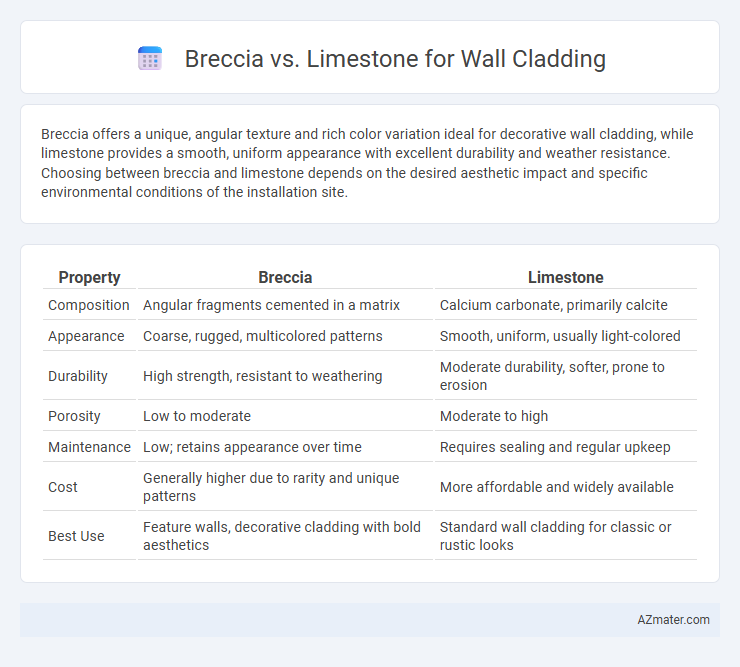Breccia offers a unique, angular texture and rich color variation ideal for decorative wall cladding, while limestone provides a smooth, uniform appearance with excellent durability and weather resistance. Choosing between breccia and limestone depends on the desired aesthetic impact and specific environmental conditions of the installation site.
Table of Comparison
| Property | Breccia | Limestone |
|---|---|---|
| Composition | Angular fragments cemented in a matrix | Calcium carbonate, primarily calcite |
| Appearance | Coarse, rugged, multicolored patterns | Smooth, uniform, usually light-colored |
| Durability | High strength, resistant to weathering | Moderate durability, softer, prone to erosion |
| Porosity | Low to moderate | Moderate to high |
| Maintenance | Low; retains appearance over time | Requires sealing and regular upkeep |
| Cost | Generally higher due to rarity and unique patterns | More affordable and widely available |
| Best Use | Feature walls, decorative cladding with bold aesthetics | Standard wall cladding for classic or rustic looks |
Introduction to Wall Cladding Materials
Breccia and limestone are popular natural stones used for wall cladding, each offering unique aesthetic and structural benefits. Breccia features a distinct fragmented texture with angular clasts cemented together, providing a dramatic and textured surface ideal for modern architectural designs. Limestone, known for its uniform grain and soft neutral tones, delivers a smooth, elegant finish that enhances both interior and exterior walls with durability and ease of maintenance.
What is Breccia?
Breccia is a sedimentary rock composed of angular fragments cemented together, often featuring a mosaic of various minerals and rock types that create a distinctive, rugged texture ideal for wall cladding. Its unique composition provides exceptional durability and a dynamic visual appeal compared to the more uniform, fine-grained texture of limestone. Breccia's natural resistance to weathering and its versatility in architectural design make it a preferred choice for both interior and exterior cladding applications.
What is Limestone?
Limestone is a sedimentary rock primarily composed of calcium carbonate, often formed from marine organisms' skeletal fragments. It features a fine to coarse texture with natural variations in color and fossil content, making it a popular choice for wall cladding due to its durability and aesthetic appeal. Compared to breccia, limestone offers a more uniform appearance and easier workability, ideal for creating smooth, elegant wall surfaces.
Aesthetic Appeal: Breccia vs Limestone
Breccia offers a unique aesthetic appeal with its bold, fragmented patterns and contrasting colors that create dynamic visual interest on wall cladding. Limestone provides a more uniform and subtle texture, featuring soft earthy tones and a natural matte finish that conveys timeless elegance. The choice between Breccia and Limestone hinges on the desired architectural statement, whether emphasizing dramatic contrast or understated sophistication.
Strength and Durability Comparison
Breccia offers superior strength and durability compared to limestone due to its composition of angular fragments cemented within a fine-grained matrix, providing enhanced resistance to impact and weathering. Limestone, while aesthetically pleasing and easier to shape, is softer and more porous, making it more susceptible to erosion and damage over time, especially in harsh climates. For wall cladding applications requiring long-term structural integrity, breccia is generally preferred for its robustness and longevity.
Weather Resistance and Maintenance Needs
Breccia offers superior weather resistance compared to limestone due to its dense composition and natural durability, making it less prone to erosion and staining in harsh outdoor conditions. Limestone, while aesthetically pleasing with its softer texture and uniform color, requires more frequent sealing and maintenance to protect against moisture absorption and freeze-thaw damage. Choosing breccia for wall cladding reduces long-term upkeep costs and enhances resilience in variable climates.
Cost Analysis: Breccia vs Limestone
Breccia wall cladding typically costs more than limestone due to its unique, fragmented appearance and rarity, which increase quarrying and processing expenses. Limestone offers a more affordable option with widespread availability and easier cutting, making it popular for budget-conscious projects. When analyzing overall cost, limestone presents lower initial investment and maintenance expenses compared to breccia's premium price and potential for higher upkeep.
Installation Considerations
Breccia and limestone differ significantly in installation for wall cladding due to their hardness and porosity; breccia's toughness requires specialized cutting tools and slower application, while limestone's softness allows easier shaping but demands careful sealing to prevent moisture damage. Proper substrate preparation is essential for both, with breccia needing stronger anchors to support its density and limestone requiring moisture barriers to enhance durability. Installation time and labor costs typically increase for breccia because of its weight and rigidity, whereas limestone offers quicker installation but higher maintenance risk.
Sustainability and Environmental Impact
Breccia, composed of angular rock fragments, typically requires less intensive quarrying and processing compared to limestone, reducing its carbon footprint for wall cladding projects. Limestone extraction and processing can lead to significant carbon emissions and habitat disruption, though its natural abundance makes it a common sustainable choice when sourced responsibly. Both materials offer durability and longevity, contributing to sustainable building practices by minimizing the need for frequent replacement.
Choosing the Right Stone for Your Wall Cladding
Breccia and limestone both offer unique aesthetic and structural qualities for wall cladding, with Breccia prized for its distinctive fragmented patterns and higher durability, while limestone provides a softer, uniform appearance and excellent workability. Selecting the right stone depends on factors such as exposure to weather, desired visual texture, and maintenance requirements, where Breccia suits exterior applications with its resistance to wear and limestone excels in interior or decorative installations. Considering these material properties alongside project-specific needs ensures an optimal balance between beauty, longevity, and functionality in wall cladding.

Infographic: Breccia vs Limestone for Wall Cladding
 azmater.com
azmater.com